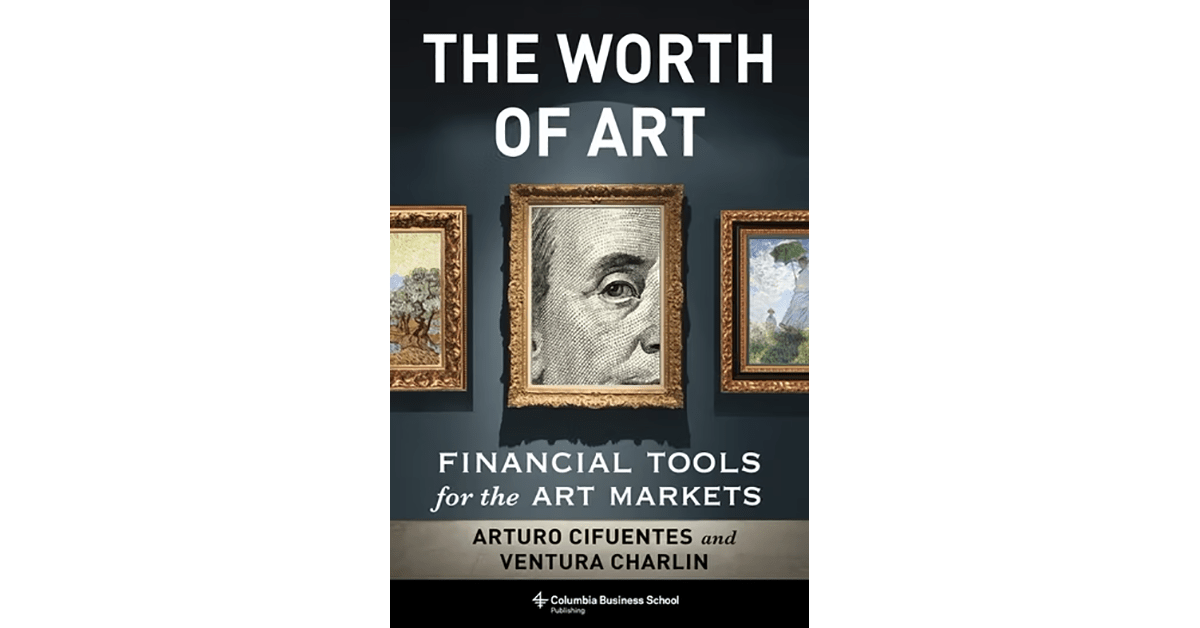[ad_1]
The Worth of Art: Financial Tools for the Art Markets. 2023. Arturo Cifuentes and Ventura Charlin. Columbia University Press.
“Sorry, but we do not have a magical equation for predicting which artists will be hot next year or whether Andy Warhol’s Marilyns will outperform the S&P 500 in the next five years.”
So write Arturo Cifuentes and Ventura Charlin in The Worth of Art: Financial Tools for the Art Markets. What, then, can readers hope to accomplish with the financial tools for navigating the art market that the book’s subtitle promises? The answer: Objectives that are actually achievable, such as determining how the market arrives at values for different works by a given artist and estimating returns on the artist’s overall body of work. There is no more reliable way of predicting the short-term price performance of a painting, the authors maintain, than there is for a common stock.
The quantitative techniques described by Cifuentes and Charlin, research associates at CLAPES-UC (Catholic University of Chile ) who also reside in New York, yield fascinating findings, such as the following, which refer to the oeuvre of Pierre-Auguste Renoir:
- If the artist’s Femme après le bain had been 10% bigger, its 1985 auction price of $2,865,892 would have been 6.5% higher. Auction prices for a painter’s work generally increase with size. Above a certain square footage, however, prices decline because extremely large works can be displayed only in museums or palaces, which limits the number of potential bidders.
- All else being equal, inclusion of one or more persons in the composition positively affects a Renoir’s price, whereas the inclusion of nudes and landscapes reduces the price per square centimeter (cm2) — the “crude but useful” metric used throughout the book.
- A Renoir landscape in a vertical frame will sell for more per cm2 than one in a horizontal frame (otherwise known, ironically, as “landscape”) format.
- A Renoir will likely fetch a higher price if sold in New York rather than elsewhere. This finding, the authors note, defies the law of one price, implying some inefficiency in the Renoir market.
Estimating returns is tougher for artworks, which typically change hands infrequently, than for securities, for which, in many cases, daily transaction prices are available. Quantifying art’s diversification effect within a portfolio composed primarily of securities and commodities similarly represents a formidable challenge. Cifuentes and Charlin address the difficulties with highly sophisticated mathematics. They acknowledge that terms such as “heteroscedasticity-consistent covariance matrix estimates” lie outside many readers’ knowledge base, but they provide an “appendix for poets” that explains their methodology’s underlying concepts.
The Worth of Art also deals with art-secured lending and the risk of guaranteeing minimum prices at auctions. Separately, Cifuentes and Charlin report that artificial intelligence (AI) has not outperformed experienced appraisers in predicting auction prices. They see potential for AI, however, in helping museums and scholars classify artworks by style or movement. Finally, the authors show how their quantitative techniques can also be applied to certain other collectibles, namely, violins, wine, and classic cars.
I found The Worth of Art both illuminating and riveting, but I do have one quibble. The authors write that “if you have never been moved by a painting . . . this book is not for you.” It is fine for individuals, if they so choose, to skew their purchases toward their esthetic preferences. Such behavior would not be appropriate for a fiduciary, however. A money manager tasked with investing in art on behalf of a client can benefit from reading this book as an aid to making objective decisions aimed solely at maximizing risk-adjusted returns. The manager would be no more disadvantaged than a counterpart dealing in commodities who has never actually seen a bushel of wheat or barrel of oil.
Furthermore, even investment professionals who have no plans of ever becoming involved in art or collectibles would do themselves a favor by grappling with Cifuentes and Charlin’s criticisms of conventional securities analysis. For example, they point out that the standard calculation of diversification benefits is dubious in view of the pronounced time dependency of correlations, “a dirty secret in financial analysis, which most financial textbooks and almost all academics hate to acknowledge or even discuss.” In the art realm, they report that, depending on which rolling seven-year period from 2004 to 2020 one selects, the return correlation between Old Masters and the Case–Shiller home price index ranges from –20.54% to +27.98%. Asset allocators dealing in more mainstream asset classes may be surprised by the instability of the correlations on which they have been basing their decisions.
The authors also reject as deficient the widely followed practice of equating risk with standard deviation of returns when calculating risk–reward ratios. They argue that such exercises should, instead, incorporate value at risk, defined as the maximum possible loss within time period x at confidence level y. In addition, Cifuentes and Charlin fault standard reports of historical asset performance for insufficient attention to real, as opposed to nominal, returns.
No text of just 241 pages could do justice to every aspect of art investment. The authors very responsibly state that thorough explanations of certain topics they touch upon lie beyond the book’s scope. One point that might have been worthy of greater prominence, however, is the disappointment that may befall investors who acquire a contemporary artist’s work with Warren Buffett’s favorite holding period (forever) in mind. The price progressions over the decades that the authors detail for various artists’ works are not invariably representative.
For example, in 2015, analyst and author Zac Bissonnette recounted that Jean-Louis-Ernest Meissonier (1815–1891) was described by his fellow artist Eugène Delacroix as “the incontestable master of our epoch. . . . Amongst all of us, surely it is he who is most certain to survive,” according to James Grant in “Attention, Larry Fink,” from the 15 May 2015 issue of Grant’s Interest Rate Observer. Meissonier’s painting Friedland sold in 1876 for what the Metropolitan Museum of Art, the painting’s current home, describes as the “then astronomical” sum of $60,000 ($1.7 million in 2023 dollars). Sadly, Bissonnette related, “The market devalued the most admired artist of the 19th century” to the point where his Un Cuirassier à Cheval sold in 2012 for the trifling sum of $1,075.50. With the rise of modernism, tastemakers concluded that his historically precise work was pedantic and that the nationalism it displayed was problematic.
All in all, however, The Worth of Art is indispensable for anyone making an initial foray into art as a vehicle for building wealth. Its techniques and insights will also be new to many seasoned art investors. Readers are on their own in determining what appeals to them from an artistic viewpoint, but this book will fill in the hardheaded financial part of the picture.
If you liked this post, don’t forget to subscribe to the Enterprising Investor.
All posts are the opinion of the author. As such, they should not be construed as investment advice, nor do the opinions expressed necessarily reflect the views of CFA Institute or the author’s employer.
Professional Learning for CFA Institute Members
CFA Institute members are empowered to self-determine and self-report professional learning (PL) credits earned, including content on Enterprising Investor. Members can record credits easily using their online PL tracker.
[ad_2]
Source link









 Bitcoin
Bitcoin  Tether
Tether  XRP
XRP  USDC
USDC  Dogecoin
Dogecoin  Lido Staked Ether
Lido Staked Ether  LEO Token
LEO Token